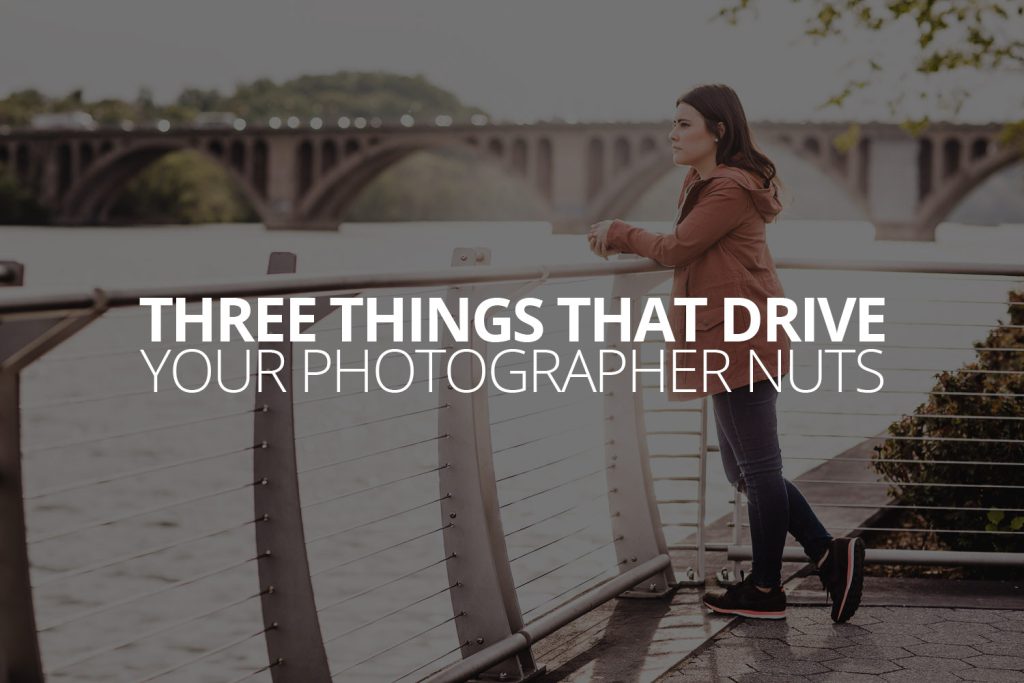Photographer’s, like any specialized professional, have some things that get under their skin. Of course, there are lots of jaded people who could fill the list with snarky remarks. “Ugh, I hate it when someone moves my camera bag”, or “My contract says no guest photographers, and so aunt Suzi with her iPad has gotta go”. Those aren’t the kinds of things I’m talking about. Professionals can have personal pet peeves—they’re entitled to them, being human after all. But the petty, personal stuff is not useful. Frankly, personal pet peeves are the professional’s problem and it’s what they signed up for when they started to use the “professional” moniker.
But, some things frustrate or annoy us because they’re explicitly getting in the way of us performing to our peak. This is not an exhaustive list, of course, but these things definitely drive us nuts. The important thing though is not that they drive us nots. It’s that they hurt your interests.
So, lets dive in.
Surprises (You Planned)
Secret dance surprises planned for weddings; A surprise wedding proposal; A birthday cake at a portrait session; Springing the CEO’s headshot on him or her at the last second.
“Surprises” come in a lot of shapes and sizes and they are always problematic for the photographer tasked with working around them. Photographer’s don’t like surprises, in as much as they are able to avoid them. A surprise dance (that we really want to capture) might not get captured if we’re all geared up to do something else. We might not get the most meaningful angles or expressions if you suddenly spring a proposal during a portrait session. A CEO who’s not ready for a headshot also doesn’t have a photographer whose ready for them.
Dealing with surprises is part of the job for photographers, but not all surprises are created equally. Surprises that you know about, but your photographer doesn’t, are a problem and we’re going to feel annoyed. Surprises, however, that no one in-the-know knows about are just part of the job. Kids do unexpected things; out-of-the-loop friends plan surprises and don’t have an avenue to inform the photographer; CEO’s sometimes, in the spur of the moment, decides he or she wants to redo their headshot. All of that may be necessarily unavoidable, but in the interest of getting the best work from your photographer, don’t keep any surprises you know of from your photographer.
Uninformed Photoshop Expectations
This is a fairly common problem, and it’s due to the chasm between Photoshop related rhetoric, and actual photoshop experience. And, granted, it’s a failure of photographers and our industry to adequately educate clients on what photoshop really is, how it works, and what it takes to get it right. So, lets try and speak to a little of that right now.
Photoshop is not magic—in spite of how much your photographer might like to refer to themselves as a ‘wizard’. Photoshop is not just a set of ‘filters’. There is no button in Photoshop to ‘remove the trash cans’ or ‘make me thinner’. Both of those things are absolutely possible, but it’s more like carpentry than wizardry. If we’re going to remove the trash cans, we actually have to replace the trash cans with something that could have conceivably been behind them, and we have to blend them until no one will notice. If we want to make you look thinner, we have to conceptualize what you would look like if you were thinner, and painstakingly push, cut and transplant pixels from elsewhere to make a convincingly authentic image.
Sometimes clients want to design their session or event based on what is possible in Photoshop, not what is reasonable. This is a significant misstep, and the assumption will drive your photographer up a wall. It will almost always be more cost effective, and efficient, to do everything you can to make yourself and your shooting space look the way you want it to look in real life, than it is to just trust that some Photoshop ‘magic’ will take care of it. It probably won’t——at least, not for a price you can stomach.
So if you want to shoot in your home, but it’s messy. Clean up. If you’re designing a layout for your wedding reception, don’t put your head table right next to the kitchen door, or under a bright exit sign. If your hair has a tendency to frizz, make a visit to the salon. All of these things are going to inflate processing time and costs if they’re left to be resolved in Photoshop.
Photography Co-Piloting
There are two primary ‘offenders’ here: Parents during portrait sessions, and aunts during wedding formals. Now, I don’t mean to over-generalize ‘aunts’, but it’s shockingly consistent, so I’m using them as the archetype.
Photography Co-Piloting is when a photographer is working with their subject, and someone inserts themselves into the equation thinking that they’re helping—or, from the photographer’s perspective, thinking the photographer doesn’t know what they’re doing.
It commonly plays out during the family formals at weddings. The photographer puts together an arrangement, and then suddenly the co-pilot chimes in with their own instructions for the group, often conflicting with the photographer’s instructions. We invariably have to ask that person to leave, which is almost always at least a little awkward. And, less assertive photographers probably don’t say anything and simply well up with frustration and maybe anger, which is not good for your images.
It’s also fairly common during family sessions, when the parents see a photographer trying out various methods to connect with a child, and misinterpret the strategy as ‘floundering’. So, they chime in. “Smile, baby”, “look at the camera, honey”, “Listen to the photographer, sweetheart”. These parenting co-pilots often think they’re helping, but they almost never are. A photographer needs to form a connection with a young subject in order to win their cooperation. What appears to the co-pilots to be a fumbling attempt to get a specific photo is often a strategic effort to build a cooperative enthusiasm in the child, and it’s almost universally de-railed by the co-pilot.
Avoid co-piloting, and trust your photographer to do what you brought them in to do. And, if you notice someone else, a wedding guest for example, co-piloting, step in and ask them to scram, which will help your photographer focus on their primary task: creating beautiful images for you.

